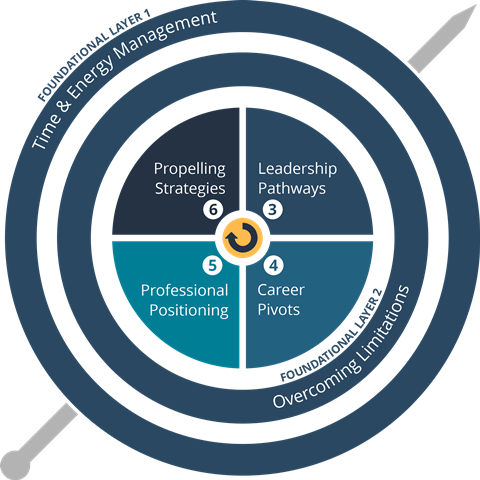Six strategic steps to help you navigate your career
Most people actively searching for a change in their career start by looking at what’s available in the marketplace based on their current set of skills and qualifications. But what if you can’t or don’t want to continue along the pathway you have created so far? How do you design and create new career pathways underpinned by the foundations you have already built?
After becoming a certified coach in 2018, I worked with thousands of clients in the Stem sector on a one-to-one basis. Without fail, the three most sought-after outcomes were a better work–life balance, more confidence, and figuring out ‘what’s next?’ in their career. All so they could make an impact and feel happy, be fulfilled and well paid for their efforts.
Over time I innovated a framework called the Career Pivots Compass to help clients achieve these outcomes, which I now use at scale. The methodology outlined below (and described in detail in my book Intentional Careers for STEM Women) will give you six strategic steps to be intentional in your career design.
The career pivots framework

You can’t get the clarity you are looking for without carving out time in your schedule for personal and professional development. If you are too busy producing, producing, producing, it’s time to look up and work on your career, not just in it. That’s why step one, a foundational layer of the Career Pivots Compass, is time and energy management: developing high-performance accountability habits to create the space for development while balancing the people and things that mean most to you. If you are not already implementing a timeboxed calendar system, where every task is prioritised and allocated a fixed amount of time, there is no better time than now.
Step two, the other foundational layer, is overcoming limitations. If you design a career from a position of eroded confidence, you are keeping yourself small. This could be anything from difficulties speaking up in meetings, inability to say no, fear of failure, doubting your capabilities and not going for opportunities. Identifying and overcoming your personal limitations means that you can create a career from the most well-resourced place possible. This will open a well of new potential that you didn’t know existed within you.
Having secured the two foundational layers, we enter the inner part of the compass, where there are four remaining steps in the strategy. The third step is to develop a leadership pathway based on your natural talents and strengths, and to find mitigation strategies for your blind spots. Instead of identifying and working on your weaknesses, focusing on your natural talents will help you to identify roles that are a perfect match for you and incorporate more joy, flow and excellence in your work. You will also learn how to flex your leadership and communication style, allowing you to work more effectively with, and through, other people.
The fourth step focuses on career pivots, helping you to answer the question, ‘what’s next?’. This is achieved by connecting the ‘dots’ between your purpose, mission and vision (avoiding the capability trap, disconnected vision and values conflicts in the process), and gaining profound clarity on where to go next in your career. Every career pivot you make will move you closer to the fullest expression of your purpose.
It has become even more essential to master the art of creating your own opportunities
It shouldn’t be this way, but in my experience a lot of job roles have been created with a specific person in mind. The advert is often tailored to that candidate’s CV and experience, which makes it easy for the selection panel to say, ‘Only this person fits the criteria, we have to hire them’. In an overcrowded job market, it has become even more essential to master the art of creating your own opportunities. That way you can become the person employers have in mind when writing their next job description. Step five, professional positioning, is a way to create your next career pivot using personal branding and online networking strategies.
It would be easy to assume the process is complete when you have a successful interview, but that couldn’t be further from the truth. Step six, propelling strategies, helps you to capitalise on starting a new role by learning techniques to negotiate your salary, develop a 30-60-90-day transition plan to increase your chances of being promoted within the first two years, and gather feedback from your last role, alongside enhancing your natural talents to inform a new 12-month personal and professional development plan.
Beware of the impulse to get away from your current situation and jump into whatever position’s available, basing your decision solely on your skills and qualifications. Instead carve out the time to implement the Career Pivots Compass framework, define what you want, and with that clarity, take confident action towards what is going to have you feeling purposeful, fulfilled and valued.












No comments yet